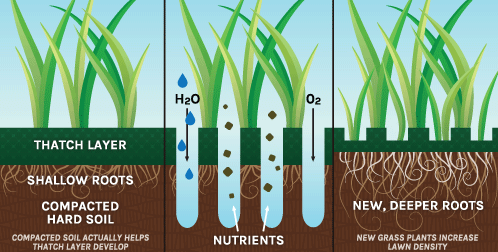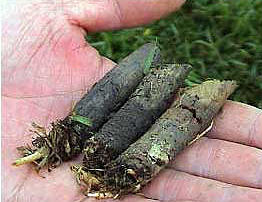Aeration Should Be Part of Everyone’s Lawn Program.
On scale of 1 to 10, core aeration rates an 10 for improving your turf quality. The benefits of aeration are so clear that it’s a standard practice used on all golf courses across the country. The benefits begin immediately and last for months.
What Is Aeration? Technically speaking, aeration is the naturally occurring process of air exchange between the soil and its surrounding atmosphere. Practically speaking, aeration is the process of mechanically removing small plugs of thatch and soil from the lawn to improve natural soil aeration. It’s commonly called “core aeration” in the lawn service industry, and you may have heard of it as soil cultivation (coring, spiking and slicing). Most homeowners simply call it aeration.

Core aeration can help make your lawn healthier and reduce its maintenance requirements through these means:
Aeration Equipment Affects The Outcome… The type of aeration equipment can determine how effective the treatment will be. In general, turf responds best when core holes are close and deep. Equipment with hollow tines removes soil cores. Equipment with open tines divots the soil surface. Aeration equipment also varies in tine size up to 3/4 inch diameter and in depth of penetration up to 4 inches, depending on the manufacturer’s specifications.
The type of aeration equipment can determine how effective the treatment will be. In general, turf responds best when core holes are close and deep. Equipment with hollow tines removes soil cores. Equipment with open tines divots the soil surface. Aeration equipment also varies in tine size up to 3/4 inch diameter and in depth of penetration up to 4 inches, depending on the manufacturer’s specifications.
How Often Should You Aerate A Lawn?
Most lawns benefit from annual aeration. Heavily used lawns, or those growing on heavy clay or subsoil’s may need more than one aeration each year. Again, turf responds best when tine spacing is closer and penetration is deeper.
When Is The Best Time To Aerate Lawns?
If you have cool season turf-grass such as Kentucky bluegrass and perennial rye-grass, both spring and fall are ideal times to aerate. In spring, aerate between March and May. Perform fall aeration between August and November. Aeration before or at the time of late season fertilization enhances root growth and improves spring green-up and growth.